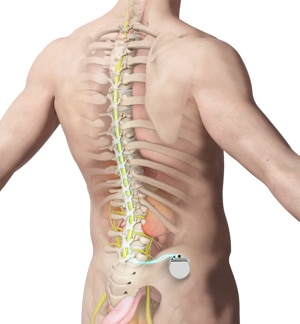SPINAL CORD
STIMULATORSPINAL CORD STIMULATOR
What is a Spinal Cord Stimulator Implant?
This injection procedure is performed to relieve pain caused by arthritis in the sacroiliac joint where the spine and hip bone meet. The steroid medication can reduce swelling and inflammation in the joint.
The patient lies face down. A cushion is placed under the stomach for comfort and to arch the back. The physician at Superior Pain Relief uses touch and a fluoroscope to find the sacroiliac joint.
A local anesthetic numbs the skin and all the tissue down to the surface of the sacroiliac joint.
The physician advances a needle through the anesthetized track and into the sacroiliac joint.
A steroid-anesthetics mix is injected into the sacroiliac joint, bathing the painful area in medication.
The needle is removed, and a small bandage is used to cover the tiny surface wound.
What does the procedure entail?
Spinal cord stimulation (also called SCS) uses electrical impulses to relieve chronic pain of the back, arms and legs. It is believed that electrical pulses prevent pain signals from being received by the brain. SCS candidates include people who suffer from neuropathic pain and for whom conservative treatments have failed.
The injection site is anesthetized. One or more insulated wire leads are inserted through an epidural needle or through a small incision into the space surrounding the spinal cord, called the epidural space.
Electrodes at the end of the lead produce electrical pulses that stimulate the nerves, blocking pain signals. The patient gives feedback to help the physician at Superior Pain Relief determine where to place the stimulators to best block the patient’s pain. The leads are connected to an external trial stimulator, which will be used for approximately one week to determine if SCS will help the patient.
If the patient and Superior Pain Relief physician determine that the amount of pain relief is acceptable, the system may be permanently implanted. At the end of the trial implantation, the leads are removed.
Our procedures?
Vertiflex/Superion – intracept/relevant medical system: The Intracept Procedure is a minimally invasive procedure that targets the basivertebral nerve for the relief of chronic vertebrogenic low back pain.
LinQ sacral fusion/Pain Technique – Sacroiliac joint fusion surgery may be recommended to treat sacroiliac joint pain when nonsurgical treatments are ineffective. In a fusion surgery, a bone graft and/or instruments are used to encourage bone growth over the sacroiliac joint and create one immobile unit. Joint fusion can effectively reduce pain and instability caused by sacroiliac joint dysfunction or inflammation (sacroiliitis).
CornerLoc™ Sacral Fusion – CornerLoc™ is a posterior approach procedure. It is done via two small incisions in the lower back, which is the shortest and minimally invasive route to the SI Joint.

